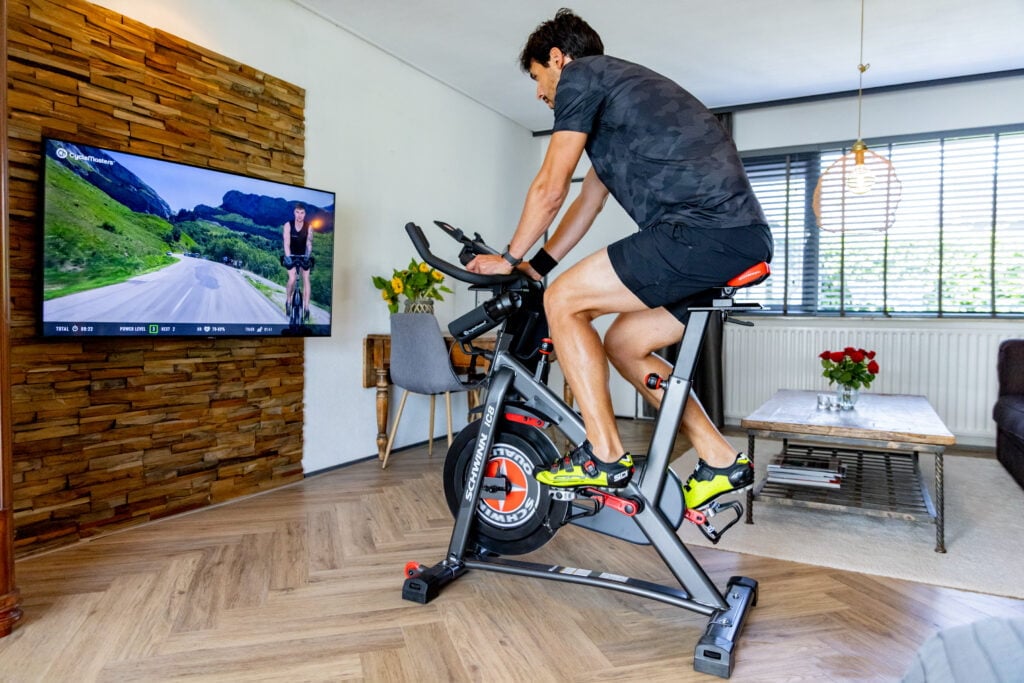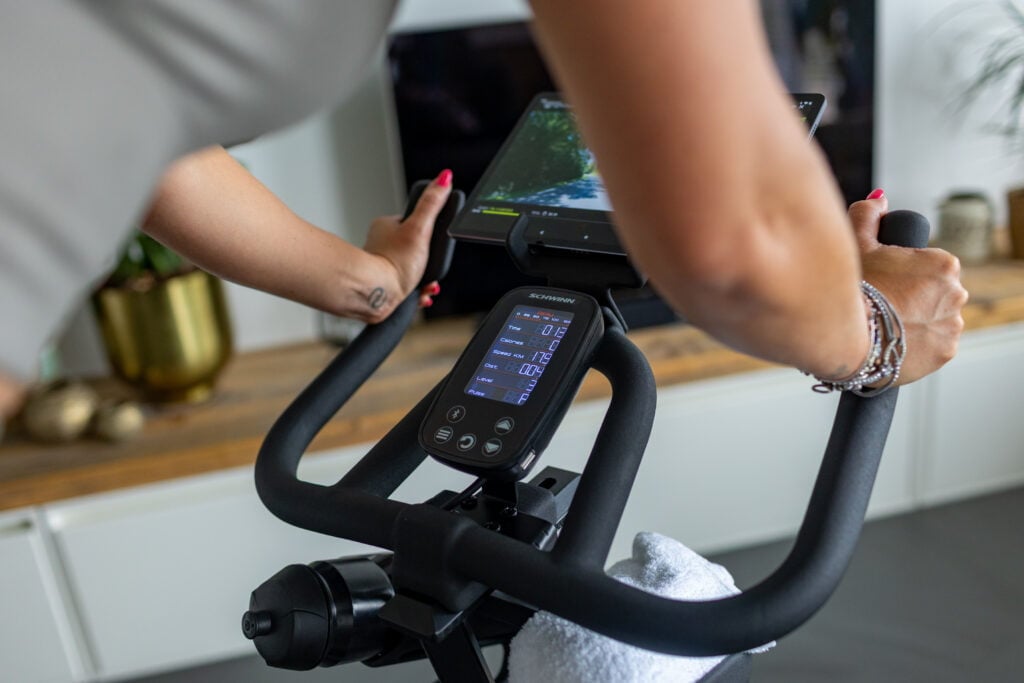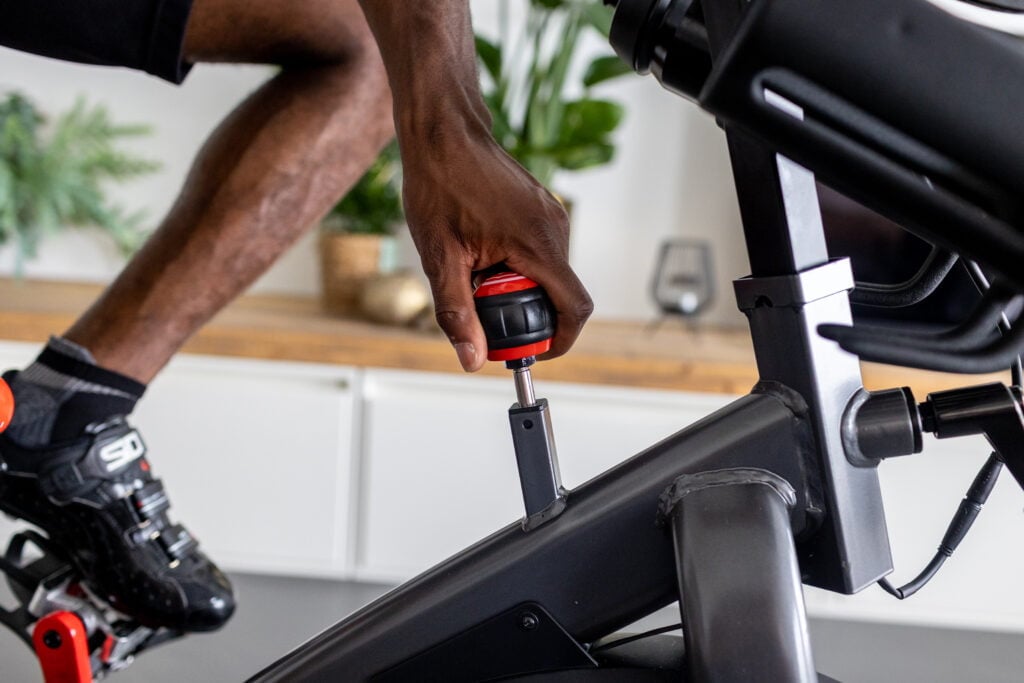A Beginner’s Guide to Common Indoor Cycling Terms and Definitions

When starting your Indoor Cycling journey, it’s essential to become familiar with the Indoor Cycling terms used in the workouts. From RPM to heart rate zones, we’ll explain the most commonly used indoor cycling terms to help you navigate this exhilarating fitness activity.
Table of Contents
RPM (Rounds per Minute)
RPM refers to the speed at which you pedal on an indoor cycling bike. It stands for Rounds Per Minute, representing the number of pedal revolutions you complete in a minute. The instructor often uses RPM as a guide to indicate the recommended pedaling speed, usually aligned with the beat of the music. Some indoor cycling bikes, like the Schwinn 800IC, have built-in RPM meters for precise tracking.
Cadence
Cadence is one of the Indoor Cycling terms also referring to the number of pedal revolutions per minute (RPM). It signifies how fast the bicycle pedals spin. A higher cadence implies a faster pedal speed, while a lower cadence suggests slower pedaling with greater force. Determining the ideal cadence depends on factors such as fitness level, goals, and bike resistance. Maintaining an appropriate cadence can help reduce stress on muscles and joints, enhancing workout efficiency.
Wattage
Wattage measures the amount of energy you produce while cycling on a spin bike, quantified in watts. It serves as a crucial indicator of workout intensity and can be utilized to track and improve performance. Tracking your wattage allows you to tailor your workouts to your specific fitness goals and compare progress. Moreover, wattage can help standardize workout intensity in group exercise classes, ensuring consistent training levels for all participants.

Heart Rate (Zones)
Heart rate zones are widely used in indoor cycling and various other sports. Your heart rate provides valuable insights into your workout intensity. Different heart rate zones indicate different training goals and outcomes. For example, the fat-burning zone falls between 50% and 65% of your maximum heart rate and is ideal for low-intensity endurance training. Interval training aims to raise and lower your heart rate rapidly for optimal fitness gains.
Training with heart rate zones is a great way to improve your fitness and lose weight. We’ve listed all the benefits for you.
Power Levels
Power Levels play a crucial role in CycleMasters’ workouts. Each power level corresponds to a specific goal or intensity. Lower levels, like 2 and 3, indicate low-intensity classes, while higher levels, such as 4 and 5, represent advanced high-intensity sessions. These power levels are linked to heart rate zones, enabling precise intensity control when paired with a heart rate monitor.
Intensity Level
During an indoor cycling workout, instructors often use resistance levels to specify the desired RPM or BPM (beats per minute) alongside resistance settings. These levels range from warm-up (level 1) to maximum intensity (level 5). Following the suggested intensity levels ensures effective training. Beginners can start with levels 2 and 3 at low resistance, while advanced cyclists may incorporate levels 3, 4, and sprints at level 5. Refer to our blog on “Sports with a Heart Rate Monitor” for a detailed understanding of these zones.

HIIT (High-Intensity Interval Training)
HIIT, or High-Intensity Interval Training, represents a workout style characterized by short bursts of intense exercise alternated with brief periods of rest. In indoor cycling, HIIT can be achieved by incorporating activities like 30-second sprints followed by 30 seconds of gentle cycling. This method efficiently burns calories and improves fitness in a relatively short timeframe.
Cardio Interval
Cardio Interval training involves alternating between intense and less intense cardiovascular exercises, often achieved by adjusting resistance and varying the pace on an indoor cycling bike. This training method effectively elevates heart rate, enhances cardiovascular health, and improves overall fitness. It aids in calorie burning, muscle strength development, and endurance building, making it a popular and challenging approach in indoor cycling.
Endurance Training
Endurance training in indoor cycling focuses on extended periods of moderate to high-intensity exercise. Participants are encouraged to sustain their effort for prolonged durations to increase heart rate, enhance breathing, and strengthen muscles. Endurance training offers benefits like improved cardiovascular health, increased energy levels, and reduced risk of chronic diseases.
Recovery
After an intense workout, recovery sessions play a vital role in allowing the body to relax and recuperate. These workouts prioritize muscle recovery and gradually lower heart rate. During recovery sessions, the spinning intensity is reduced, emphasizing light cardio exercises and controlled movements. Slower-paced cycling, reduced resistance, and relaxation exercises like stretching and breathing techniques are commonly incorporated. Regular recovery training aids injury prevention and promotes better post-workout recovery for future sessions.
Spinning® vs. Indoor Cycling
While often used interchangeably, Spinning® and Indoor Cycling have slight differences. Both involve using specialized bikes and performing similar exercises with varying intensities under the guidance of an instructor. Spinning® is a registered trademark associated with the brand-specific program developed by Johnny G, whereas Indoor Cycling refers to the broader activity. To learn more about the distinction, refer to our blog on “The Difference Between Spinning® and Indoor Cycling.
Common Indoor Cycling Exercises
In addition to the above Indoor Cycling terms, there are also terms often used in class that designate the different exercises. If you are just starting out with Indoor Cycling, you may need a few lessons to master these exercises. We have included each of the exercises in our workout collection as learn the moves videos, but you can also find them on our YouTube channel.
Do you enjoy tracking your progress and want to know more about this? Then read more in the blog Sports with statistics. More Indoor Cycling terms are explained to you here.
